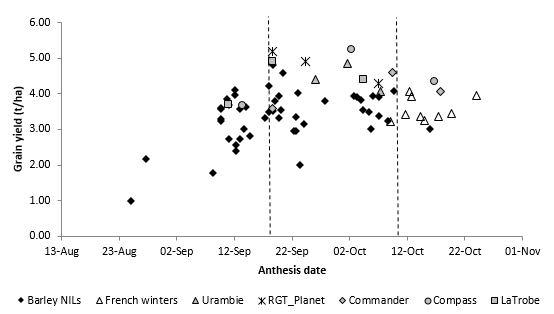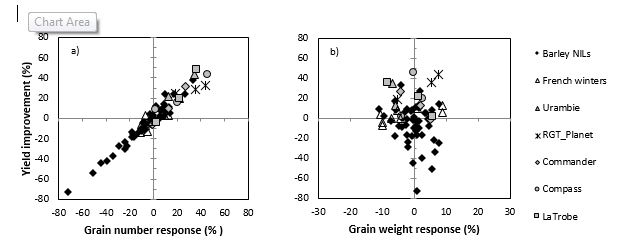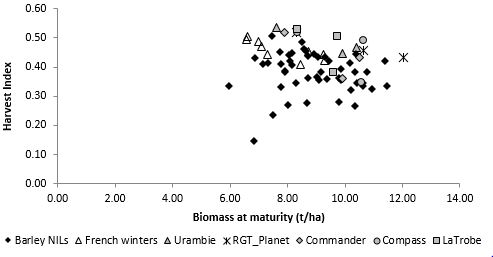Phenology responses of barley in southern NSW
Author: Felicity Harris (NSW Department of Primary Industries Wagga Wagga), Kenton Porker (SARDI), Ben Trevaskis (CSIRO Canberra), David Burch (NSW Department of Primary Industries, Condobolin). | Date: 13 Feb 2018
Take home messages
- Barley genotypes with alternative development patterns showed variation in flowering date in response to sowing time.
- High grain yields were achieved across a range of barley variety x sowing date combinations, and through varied yield components.
Background
The adaptation and yield potential of barley are dependent on matching phenology and sowing time of varieties to ensure heading date and grain formation occurs at an optimal time, with minimal exposure to abiotic stresses. In recent years, early heading date has been positively correlated with grain yield, and as such there has been a breeder focus on varieties with rapid development. This paper discusses phenology responses of some current barley varieties in conjunction with some novel genetic lines, yield responses with respect to sowing date, and opportunities for genotypes with alternative development patterns in southern NSW.
Barley phenology and yield development
The life cycle of barley consists of a series of phases with key development events which mark their start and completion. The timing and duration of these phases are directly related to the formation of specific grain yield components. These include the vegetative, early reproductive, late reproductive and grain filling phases. During the vegetative phase, leaves and tillers are initiated prior to the transition to the early reproductive stage, when spikelet development commences.
Spikelet primordia continue to be initiated up until awn primordia appearance, which coincides with early stem elongation, and marks the transition to the late reproductive stage. This is also indicative of the determination of maximum grain yield potential. In the late reproductive phase, spike growth and differentiation occur up until anthesis. Following anthesis, and during the grain-filling phase, the embryo develops, producing a viable seed for a subsequent generation — this phase also coincides with the establishment of grain weight (Kirby and Appleyard, 1987).
The grain yield of barley is therefore determined by three main components — spike density, grains per spike, and individual grain weight, with phenology having a direct effect on the formation of each of these components and overall grain yield. Grain yield has been more closely associated with grain number than grain weight in barley — this has also been maintained in environments characteristic of terminal drought (Porker et al. 2016).
Drivers of phenology
Developmental progression is controlled by the interaction of genotype with temperature and photoperiod. In barley, patterns in phasic development are dependent on three sets of genes which control vernalisation (Vrn) response, photoperiod (Ppd) response and earliness per se. Accumulated temperature generally accelerates development of all phases, while there is an additional effect of vernalisation in some responsive genotypes, by which progression from vegetative to reproductive development is dependent on fulfilling a response to cold temperatures.
The direct influence of vernalisation is to alter the length of the vegetative phase, which can indirectly affect the duration of subsequent phases. As barley is a long-day (LD) plant, the rate of development is increased with longer day-lengths. However, individual genotypes of current commercial varieties have varying levels of responsiveness to photoperiod. In photoperiod sensitive genotypes, short-day (SD) conditions prolong the vegetative phase and delay the transition to reproductive development, while long-day conditions decrease time to floral initiation. In vernalisation responsive genotypes, following saturation of the vernalisation response, long days hasten progressive inflorescence development and stem elongation. Vernalisation is essentially the prerequisite for long days to reduce the time to flowering (Distelfeld and Dubcovsky, 2009). Barley genotypes differ in flowering time after vernalisation and photoperiod responses have been accounted for — this variation is generally referred to as earliness per se (Eps) (Karsai et al. 2001).
Phasic development is readily modified by selection and breeding which can lead to improved adaptation to an environment. The most adapted Australian varieties are characterised as having a relatively short duration to heading and strong response to increase in photoperiod, for example cv. La Trobe (Porker et al. 2016). Currently, there is only one winter variety suited to early sowing cv. Urambie, which has been bred for grazing purposes afforded by an extended vegetative phase in response to a vernalisation requirement. However, recent introductions from Europe of some alternative long-season spring varieties, such as RGT Planet, may present opportunities for earlier sowing.
2017 results
A field experiment was conducted at Wagga Wagga Agricultural Institute, NSW, to determine the influence of variation in phenology patterns on grain yield and components. Sixteen near isogenic lines (NILs) were used that contained different combinations of vernalisation and photoperiod genes derived from ultra-early barley genotype WI4441 (developed by Ben Trevaskis, CSIRO), three French winter genotypes (Secobra Research) with strong vernalisation and five commercial genotypes with varied development. These were sown on three dates, 21 April, 8 May and 26 May in 2017.
Phenology and grain yield
There was substantial variation in flowering date for the genotypes sown across the three sowing dates. Optimum grain yield is achieved when genotypes are matched with sowing date to ensure flowering occurs at an appropriate time. In 2017, the genotypes and sowing date combinations which flowered mid-September to early October generally had the greatest yields (Figure 1). In southern NSW, this response is common, generally driven by the high risk of frost damage early, and heat and moisture stress later.
Trials conducted from 2014-2017 have indicated that mid-May sowing of many spring varieties, such as LaTrobe, Compass and Commander achieve optimal flowering times, however, the increased photoperiod of Commander means it flowers slightly later than the faster developing genotypes. Urambie is suited to earlier sowing due to its vernalisation and photoperiod responses, and is relatively stable in its flowering response across sowing dates. RGT Planet is a longer-season spring genotype which offers an alternative phenology pattern, in which its vegetative period is slightly longer than spring types, with an extended reproductive phase. RGT Planet has shown some flexibility across sowing dates and is capable of being sown earlier than most other fast developing commercial spring genotypes.
The NILs were all relatively quick to flower, however the genetic variation in phenology responses indicated there may be alternative development patterns suitable for achieving optimal flowering time in southern NSW worth exploring. The French winter lines had later flowering dates compared to the current commercial genotypes, indicative of a stronger vernalisation response comparative to Urambie. Despite flowering outside the optimal time, they achieved relatively high stable grain yields across the sowing dates, and highlight opportunities for slower developing barley genotypes, which may be better suited to an earlier April sowing.
Figure 1. Relationship between anthesis date and grain yield of genotypes sown 21 April, 8 May and 26 May at Wagga Wagga in 2017. Dashed lines indicate optimal flowering period.
Grain yield components
Results from the 2017 field experiments indicated that relative to the site mean, grain yield was predominately driven by increased grain number responses in most varieties (Figure 2a). However, there was varied influence of grain weight on yield improvement among genotypes for the three sowing dates (Figure 2b). Adapted varieties RGT Planet and Compass maintained a relative high grain number and weight across most sowing times. In contrast, Urambie had a trade-off between grain number and grain weight at all sowing times, as did LaTrobe when it achieved highest yields from 8 May sowing date.
Figure 2. Relationship between yield improvement and its components — a) grain number (grains/m2), and b) average grain weight (mg). Data is expressed as a percentage of the site mean.
In 2017, harvest index (HI) (ratio of grain yield to biomass) was maintained under high biomass levels (Figure 3). An analysis of the grain yield components shows that barley genotypes vary in their ability to achieve yield in response to sowing time. For example, LaTrobe had the highest grain yield from sowing on 8 May, and this was largely attributed to a high number of spikes/m2 while maintaining grains/spike and moderate grain weight. In contrast, RGT Planet had highest grain yield from an earlier 21 April sowing date, achieved through a high spike density coupled with high grain weights, with moderate grains/spike.
Figure 3. Relationship between HI and biomass at maturity of genotypes sown 21 April, 8 May and 26 May at Wagga Wagga in 2017.
Summary
Our data suggested there is scope for exploring alternative development genes for more varied phenology patterns in barley for earlier April sowing, but these options are currently limited. There are differences in flowering date and yield development in response to sowing time in the barley NILs, French winter lines, and commercial varieties that growers can exploit. UrambieA and RGT Planet offer opportunities for earlier sowing compared with other spring varieties best suited to mid-May sowing in southern NSW. However, RGT Planet does not have a vernalisation requirement like UrambieA and growers should be cautious when considering sowing earlier than May in frost prone environments.
Compared to other cereals, barley is an adaptive crop, capable of achieving high stable grain yields across a range of genotype x sowing time combinations and through varied yield components. However, matching variety and sowing time to achieve flowering at an appropriate time for the growing environment is the most effective management strategy in optimising grain yields.
Acknowledgements
This research is a collaborative project between the GRDC and the Department of Primary Industries. The research undertaken as part of this project is made possible by the significant contributions of growers through both trial cooperation and the support of the GRDC — the author would like to thank them for their continued support.
Sincere thank you to Hugh Kanaley, Greg McMahon, Cameron Copeland, Danielle Malcolm, Jessica Simpson and Hayden Petty for their technical assistance in 2017.
References
Distelfeld, A., Li, C., Dubcovsky, J. (2009). Regulation of flowering in temperate cereals. Current Opinion in Plant Biology. 12, 178–184.
Karsai, I., Mészáros, K., Láng, L., Hayes, P.M., Bedö, Z. (2001). Multivariate analysis of traits determining adaptation in cultivated barley. Plant Breeding. 120, 217–222.
Porker, K., Eglington, J., Coventry, S., Fettell, N. (2016). Improvement of yield and adaptation by manipulating phenology genes. In G. Zhang and C. Li (Eds), Exploration, Identification and Utilisation of Barley germplasm (pp.241-264). Elsevier Inc.
Contact details
Felicity Harris
NSW Department of Primary Industries, Wagga Wagga
0458 243 350
felicity.harris@dpi.nsw.gov.au
@NSWDPI_Agronomy
GRDC Project Code: DAN00173,
Was this page helpful?
YOUR FEEDBACK



